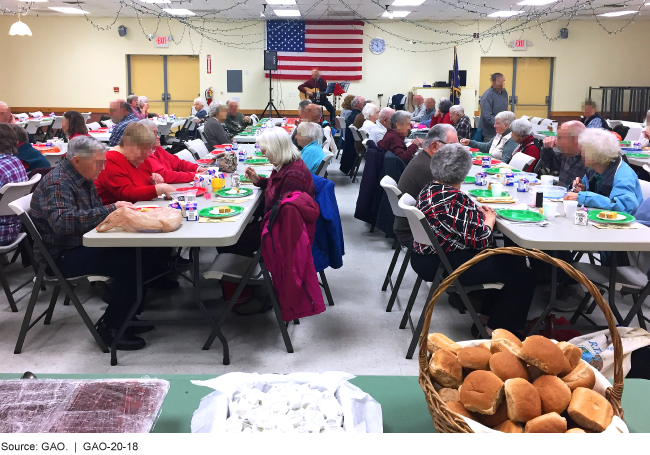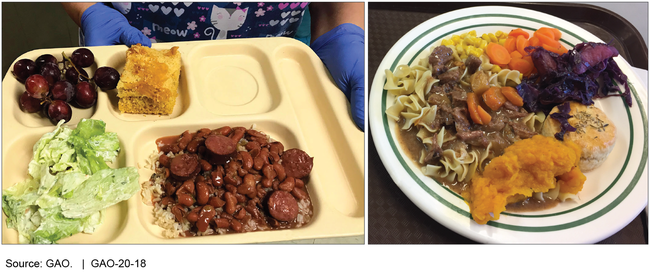Nutrition Assistance Programs: Agencies Could Do More to Help Address the Nutritional Needs of Older Adults
Fast Facts
Federal nutrition guidelines are the basis for nutrition assistance programs that serve older adults. However, the guidelines focus on a healthy population and not on the needs of many older adults, such as those with common health conditions and those over age 70. Most older adults have more than one chronic condition, such as diabetes or heart disease.
As the population ages, demand for federal nutrition assistance programs will increase. We recommended that the Department of Health and Human Services develop a plan to focus on older adults’ needs in a future update to the guidelines.

Senior citizens sharing a meal
Highlights
What GAO Found
Research shows that nutrition can affect the health outcomes of older adults. Federal nutrition guidelines provide broad guidance for healthy populations, but do not focus on the varying nutritional needs of older adults. Department of Health and Human Services (HHS) data show that the majority of older adults have chronic conditions, such as diabetes or heart disease. Research shows that such individuals may have different nutritional needs. As older adults age, they may also face barriers, such as a reduced appetite, impairing their ability to meet their nutritional needs. HHS plans to focus on older adults in a future update to the guidelines, but has not documented a plan for doing so. Documenting such a plan could help ensure guidelines better address the needs of the population.
Of the six federal nutrition assistance programs serving older adults, four have requirements for food that states and localities provide directly to participants, and federal agencies oversee states' monitoring of these requirements. In HHS's and U.S. Department of Agriculture's (USDA) meal programs, states must ensure meals meet requirements. Yet, HHS does not gather information from states, such as approved menus, to confirm this, and localities in two of the four selected states said state monitoring of menus was not occurring. Further, USDA regional officials told GAO they lack information on how meal programs operate at adult day care centers as they primarily focus on other sites for their on-site reviews. Additional monitoring could help HHS and USDA ensure meal programs meet nutritional requirements and help providers meet older adults' varying needs.
Examples of Lunches Served to Older Adults through Nutrition Programs in Selected States

In the states GAO selected, meal and food providers of the four nutrition programs with nutrition requirements reported various challenges, such as an increased demand for services. Providers in three of the four states reported having waiting lists for services. Providers of HHS and USDA meal programs in all four states also reported challenges tailoring meals to meet certain dietary needs, such as for diabetic or pureed meals. HHS and USDA have provided some information to help address these needs. However, providers and state officials across the four states reported that more information would be useful and could help them better address the varying nutritional needs of older adults.
Why GAO Did This Study
The U.S. population is aging and, by 2030, the U.S. Census Bureau projects that one in five Americans will be 65 or older. Recognizing that adequate nutrition is critical to health, physical ability, and quality of life, the federal government funds various programs to provide nutrition assistance to older adults through meals, food packages, or assistance to purchase food. This report examines (1) the relationship of older adults' nutrition to health outcomes and the extent to which federal nutrition guidelines address older adults' nutritional needs, (2) nutrition requirements in federal nutrition assistance programs serving older adults and how these requirements are overseen, and (3) challenges program providers face in meeting older adults' nutritional needs. GAO reviewed relevant federal laws, regulations, and guidance and conducted a comprehensive literature search; visited a nongeneralizable group of four states—Arizona, Louisiana, Michigan, and Vermont—and 25 meal and food distribution sites, selected for a high percentage of adults 60 or older, and variations in urban and rural locations, and poverty level; and interviewed officials from HHS, USDA, states, national organizations, and local providers.
Recommendations
GAO is making five recommendations, including that HHS develop a plan to include nutrition guidelines for older adults in a future update, and that HHS and USDA improve oversight of meal programs and provide additional information to meal providers to help them meet older adults' nutritional needs. HHS and USDA generally concurred with our recommendations.
Recommendations for Executive Action
| Agency Affected | Recommendation | Status |
|---|---|---|
| Administration for Community Living | The Administrator of ACL should work with other relevant HHS officials to document the department's plan to focus on the specific nutritional needs of older adults in the 2025-2030 update of the Dietary Guidelines for Americans, which would include, in part, plans to identify existing information gaps on older adults' specific nutritional needs. (Recommendation 1) |
HHS took action to implement this recommendation. HHS's Administration for Community Living (HHS/ACL) documented its role in joining the effort led by the National Institutes of Health to update the Dietary Reference Intakes (DRI), which will be used to inform the 2025-2030 Dietary Guidelines for Americans. This effort includes special considerations for each age-sex group across the life span, including older adults ages 65 and older. The nutrient of focus in FY2023 is protein, a particularly relevant nutrient for the health of older adults. Through funding, ACL is also supporting a multi-year interagency agreement that will provide for additional nutrient area reviews during FY2022 through 2026. HHS's Office of the Assistant Secretary for Health Office of Disease Prevention and Health Promotion is leading both the interagency agreement as well as the development of the 2025-2030 Dietary Guidelines. In addition, as a member of the DRI Project Steering Committee, ACL will have opportunities to identify existing information gaps on older adults' specific nutritional needs as well as advise the committee's work products to address these gaps.
|
| Administration for Community Living | The Administrator of ACL should direct regional offices to take steps to ensure states are monitoring providers to ensure meal consistency with federal nutrition requirements for meals served in the congregate and home-delivered meal programs. (Recommendation 2) |
HHS took action to implement this recommendation. The Regional Administrators of HHS' Administration for Community Living (ACL) disseminated an email to states reminding them of their oversight and stewardship responsibility for nutrition programming and funding, including their role in monitoring providers of meals to ensure consistency with federal nutrition requirements. Through its national resource center, ACL shared technical assistance training materials, tools, and other resources to assist states in monitoring meal providers. In addition, ACL published a final rule in February 2024 implementing the Older Americans Act and reaffirming nutrition programming requirements found in statute, prior regulations, and existing policies. ACL also hosted a webinar series to support states' understanding of nutrition programming requirements and compliant implementation. These steps can help ensure states are monitoring providers of congregate and home-delivered meals to ensure meals are consistent with federal nutrition requirements.
|
| Food and Nutrition Service | The Administrator of FNS should take steps to improve its oversight of CACFP meals provided in adult day care centers. For example, FNS could amend its approach for determining federal onsite reviews of CACFP meal providers to more consistently include adult day care centers. (Recommendation 3) |
The Department of Agriculture (USDA) took action to implement this recommendation. USDA's Food and Nutrition Service (FNS) documented in an email to its Regional Office Directors that the regions include an adult day care center as one of their CACFP accompanied reviews in states where there are adult day care centers that participate in CACFP. We believe this action will help improve FNS's oversight of the adult day care portion of the CACFP.
|
| Administration for Community Living | The Administrator of ACL should centralize information on promising approaches for making meal accommodations to meet the nutritional needs of older adult participants in the congregate and home-delivered meal programs, for example in one location on its National Resource Center on Nutrition and Aging website, to assist providers' efforts. (Recommendation 4) |
As of September 2021, the National Resource Center on Nutrition and Aging website, which is sponsored by ACL, has been revamped, and includes promising approaches for making meal accommodations to meet the nutrition needs of older adult participants in the congregate and home-delivered meal programs. The website includes examples of innovations in nutrition programs and services, such as developing modified meals for reduced dental functions. It also includes case studies, success stories, and other nutrition resources for specific older adult populations. The steps ACL has taken to centralize information on promising approaches to meeting older adults' needs for certain meal accommodations can help providers better meet the nutritional needs of older adult participants in congregate and home-delivered meal programs.
|
| Food and Nutrition Service | The Administrator of FNS should take steps to better disseminate existing information that could help state and local entities involved in providing CACFP meals meet the varying nutritional needs of older adult participants, as well as continue to identify additional promising practices or other information on meal accommodations to share with CACFP entities. (Recommendation 5) |
As of September 2021, the Department of Agriculture's Food and Nutrition Service (FNS) has made several new resources available to help state and local entities meet the varying nutritional needs of older adults participating in the CACFP. Resources include worksheets on meal patterns, information on common nutritional areas of concern for older adults, menu planning tips, and suggestions for meal accommodations, modifications and other flexibilities to address the varying needs of older adults. In addition, in July 2021, FNS released a series of fact sheets with tips for planning, preparing, and serving meals for adults in the CACFP, such as mealtimes and feeding techniques for adult day care participants. To disseminate resources, FNS stated that its Team Nutrition promoted the CACFP meal pattern for adult participants through social media, newsletters, webinars, and national conference presentations. FNS also stated that its staff held a virtual listening session focused on the needs, challenges and successes related to serving older adults in the CACFP, presented a workshop, and moderated a discussion board specific to adults in the CACFP during the national CACFP annual conference. The steps FNS has taken to disseminate existing and new information on meals pattern requirements and meal accommodations for older adults participating in the CACFP can help state and local entities involved in providing CACFP meals better meet the varying nutritional needs of older adults.
|
